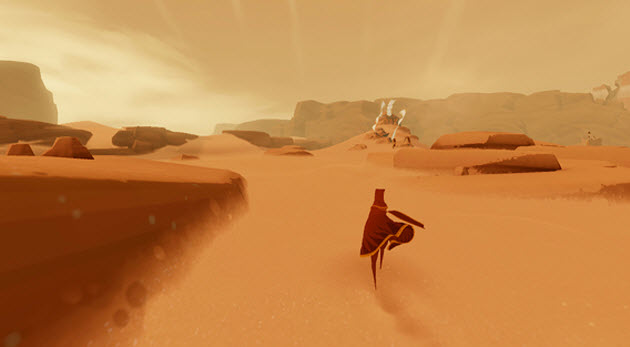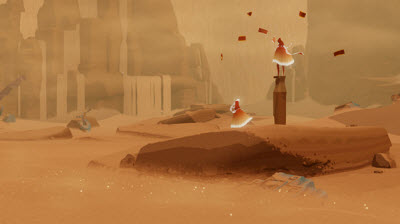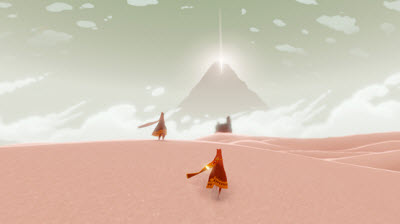 Journey promises to be one of the most interesting video games of the year. Having played one of its levels, I have no idea what it’s about, but I really want to find out more.
Journey promises to be one of the most interesting video games of the year. Having played one of its levels, I have no idea what it’s about, but I really want to find out more.
 That’s to be expected, since the game is being created for the PlayStation Network by Thatgamecompany, a Los Angeles game studio that brought us alternative games such as Flower and Flow. The company intentionally makes games that are unlike anything you’ve experienced. Journey is one of the finest examples of how creativity is still possible in the multibillion dollar console game industry, particularly among the small indie game studios that are similar to indie film makers.
That’s to be expected, since the game is being created for the PlayStation Network by Thatgamecompany, a Los Angeles game studio that brought us alternative games such as Flower and Flow. The company intentionally makes games that are unlike anything you’ve experienced. Journey is one of the finest examples of how creativity is still possible in the multibillion dollar console game industry, particularly among the small indie game studios that are similar to indie film makers.
At the beginning of the game, you play a robed character walking around in the sand. A sweet melody plays, but there are no words. No narration. Nothing tells you what to do. You just push your analog stick on the controller forward and your character starts moving through the sand.
 Jenova Chen (pictured), one of the game’s creators at Thatgamecompany, said that the past games the company did were more abstract and not realistic. They were accessible and artistically crafted, but weren’t violent in any way.
Jenova Chen (pictured), one of the game’s creators at Thatgamecompany, said that the past games the company did were more abstract and not realistic. They were accessible and artistically crafted, but weren’t violent in any way.
“We look at games and how they can produce more primal emotions,” Chen said. “But most games are just about competition or violence.”
In Flower, Thatgamecompany managed to pull off a story with a nonviolent theme. You play the wind in the dream of a flower in the middle of a dying city. I still remember how beautiful the colors were in that game and how beautifully rendered the grass was as the wind blew through it.
With Journey, the sand gives me that same reaction. The sand is a graphics marvel. It moves and looks and behaves physically as you expect sand would. It makes a sound when you walk through it, and it brings a smile to your face. In short, walking through sand in this game is fun.
It’s very unusual for a company to spend so much time getting something like sand right. Thatgamecompany was founded in 2006 by Chen, creative director, and Kellee Santiago, president. Both of them were graduate students at the University of Southern California’s School of Cinematic Arts, Interactive Media Program, when they started making games. Their first experiments, Cloud and Flow, were unique creations. The company gathered steam when Sony published Flow on the PlayStation Network in 2007 and then Flower in 2009. It has just a dozen employees.
Robin Hunicke, producer of the Journey game, said in a recent talk that while AAA games may be all about violence, her company wants to make EEE games, where the E stands for “elegant,” “expressive,” and “emotional.”
Chen added, “We want to explore games in different areas of the emotional spectrum. We knew this game would be on the PlayStation Network, so we wanted to have you explore unique emotions and apply them in the online space. You can experience this game and play it together with people in a connected environment.”
 For Hunicke, an elegant game is one that is easy to use. It is broadly accessible. This game fits that definition since it uses the simplest of the button and motion controls for the PlayStation 3 controller. By expressive, she means that the game should allow a player to communicate their preferences and express their affinity for something in a social way. That means you can let users create their own puzzles or designs within the larger game. The opposite of expressive is scripted, where the game developer controls exactly what the player can or cannot do.
For Hunicke, an elegant game is one that is easy to use. It is broadly accessible. This game fits that definition since it uses the simplest of the button and motion controls for the PlayStation 3 controller. By expressive, she means that the game should allow a player to communicate their preferences and express their affinity for something in a social way. That means you can let users create their own puzzles or designs within the larger game. The opposite of expressive is scripted, where the game developer controls exactly what the player can or cannot do.
Chen said that the inspiration for Journey had to do with creating something that was the opposite of what you can usually do in a game.
“You can do things like drive fast cars or get information at your fingertips in today’s society. In our games, we can do the same kinds of things. When you play multiplayer games, you are generally trying to get the best individual statistics. What if we remove that and give you a new multiplayer online experience that connects you?” Chen said.

So what is Journey all about? Hunicke explains her approach to the game as an attempt “to remove those obstacles between two people on a journey.” I didn’t really know what he was talking about until I played more of the game. I walked from one spot in the desert to another. The game showed me silently how to tilt the controller so that I could shift the point of view. I visited a ruin, There were some strange markings on it. I walked over to spots where I could see little kites or flags flying around in circles. I walked up to them and they gave me the energy to jump into the air and fly.
I looked out in the landscape and figured that the point of the game was to walk from one set of flags to another. When you collect flags at one point, you can extend a magic carpet that takes you up to the top of a ruined stone building. Then you keep collecting flags until you extend that magic carpet all the way to your destination. Once you are there, you meet a mysterious character, sort of like a big nun, who communicates to you in a different language. From there, you move on to the next part of the journey.
I see how you can play it with someone else. You can collect flags together and get the tasks done more quickly, allowing you to progress through the game faster. There is no standard multiplayer feature such as statistics that log how many points you have. Always, in the distance, you can see the mountain looming before you, getting bigger. It makes you feel small.
I have no doubt that Journey will be a unique experience. But with so little action, the game developers will have to make sure the experience never becomes boring.
 We’ll be exploring the most disruptive game technologies and business models at our third annual GamesBeat 2011 conference, on July 12-13 at the Palace Hotel in San Francisco. It will focus on the disruptive trends in the mobile games market. GamesBeat is co-located with our MobileBeat 2011 conference this year. To register, click on this link. Sponsors can message us at sponsors@venturebeat.com. To enter the Who’s Got Game? contest for the best game startup, click here.
We’ll be exploring the most disruptive game technologies and business models at our third annual GamesBeat 2011 conference, on July 12-13 at the Palace Hotel in San Francisco. It will focus on the disruptive trends in the mobile games market. GamesBeat is co-located with our MobileBeat 2011 conference this year. To register, click on this link. Sponsors can message us at sponsors@venturebeat.com. To enter the Who’s Got Game? contest for the best game startup, click here.
VentureBeat's mission is to be a digital town square for technical decision-makers to gain knowledge about transformative enterprise technology and transact. Learn More
